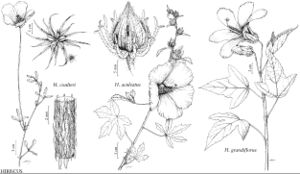Difference between revisions of "Hibiscus aculeatus"
Fl. Carol., 177. 1788.
FNA>Volume Importer |
imported>Volume Importer |
||
| (6 intermediate revisions by 2 users not shown) | |||
| Line 13: | Line 13: | ||
}}{{Treatment/ID/Special_status | }}{{Treatment/ID/Special_status | ||
|code=F | |code=F | ||
| − | |label= | + | |label=Illustrated |
}} | }} | ||
|basionyms= | |basionyms= | ||
| Line 31: | Line 31: | ||
|elevation=0–100 m | |elevation=0–100 m | ||
|distribution=Ala.;Fla.;Ga.;La.;Miss.;N.C.;S.C.;Tex. | |distribution=Ala.;Fla.;Ga.;La.;Miss.;N.C.;S.C.;Tex. | ||
| − | |discussion=<p>Hibiscus aculeatus ranges northeast to Carteret County in North Carolina, south to Lake County in central Florida, and west to Hardin County in eastern Texas. Within these limits its distribution is confined entirely to the coastal plain.</p> | + | |discussion=<p><i>Hibiscus aculeatus</i> ranges northeast to Carteret County in North Carolina, south to Lake County in central Florida, and west to Hardin County in eastern Texas. Within these limits its distribution is confined entirely to the coastal plain.</p> |
|tables= | |tables= | ||
|references= | |references= | ||
| Line 40: | Line 40: | ||
-->{{#Taxon: | -->{{#Taxon: | ||
name=Hibiscus aculeatus | name=Hibiscus aculeatus | ||
| − | |||
|authority=Walter | |authority=Walter | ||
|rank=species | |rank=species | ||
| Line 54: | Line 53: | ||
|publication title=Fl. Carol., | |publication title=Fl. Carol., | ||
|publication year=1788 | |publication year=1788 | ||
| − | |special status=Endemic; | + | |special status=Endemic;Illustrated |
| − | |source xml=https:// | + | |source xml=https://bitbucket.org/aafc-mbb/fna-data-curation/src/2e0870ddd59836b60bcf96646a41e87ea5a5943a/coarse_grained_fna_xml/V6/V6_466.xml |
|subfamily=Malvaceae subfam. Malvoideae | |subfamily=Malvaceae subfam. Malvoideae | ||
|genus=Hibiscus | |genus=Hibiscus | ||
Latest revision as of 22:21, 5 November 2020
Herbs, perennial, or subshrubs, to 0.5–1(–2) m, herbage scabrous throughout, hairs scattered, stellate, stout, pustular-based. Stems additionally with line of fine, curved hairs. Leaves: stipules linear or linear-filiform, 2–6 mm; petiole of lower leaf 2/3 to equaling blade, much shorter in inflorescence, with fine, curved hairs adaxially in addition to normal pubescence; blade broadly to transversely ovate, 3–5-fid, sometimes lobed, often unlobed in inflorescence, 3.5–9.5 × 4.5–13.5 cm, narrower in inflorescence, base cordate to cuneate, lobes obovate to oblanceolate, margins coarsely and irregularly crenate-serrate, apex acute to short-acuminate, surfaces scabrous, slitlike nectary present abaxially at or near base of midvein. Inflorescences solitary flowers in axils of distal leaves, or appearing racemose by reduction of subtending leaves. Pedicels inconspicuously jointed at base, to 1.5 cm; involucellar bractlets 8–11, linear-subulate, 1–1.6 cm, margins not or inconspicuously ciliate, apex 2-fid, bristly-hairy. Flowers horizontal or declinate; calyx divided 2/3 length, campanulate, 1.6–2.8 cm, lobes triangular, with 3 prominent, often reddish ribs, 1 medial, 2 marginal, medial with prominent nectary, apices acute or acuminate, veins and sometimes spaces between them with conspicuous simple or few-armed, stellate hairs; corolla funnelform, petals pale yellow to white, dark red basally, obovate, 5–8 × 2.5–5 cm, margins ± entire to crenate-dentate, sometimes undulate, minutely hairy abaxially where exposed in bud; staminal column straight, dark red, 2–4.5 cm, bearing filaments ± throughout, free portion of filaments not secund, 1.5–2.5 mm; pollen dark red; styles dark red, pink, or white, 9–22 mm; stigmas dark red, pink, or white. Capsules medium brown to stramineous, ovoid, 1.2–2 cm, apex acute to acuminate, variously antrorsely hispid, more minutely stellate-hairy. Seeds reddish brown to dark brown, sometimes with raised, pale concentric lines, angulately reniform-ovoid, 3.3–4.5 mm, sparingly to moderately papillose-verrucose. 2n = 72.
Phenology: Flowering Jun–Sep.
Habitat: Pine savannas, flatwoods, swales, roadside ditches
Elevation: 0–100 m
Distribution

Ala., Fla., Ga., La., Miss., N.C., S.C., Tex.
Discussion
Hibiscus aculeatus ranges northeast to Carteret County in North Carolina, south to Lake County in central Florida, and west to Hardin County in eastern Texas. Within these limits its distribution is confined entirely to the coastal plain.
Selected References
None.
